IDEX Online Research: Jewelry Price Inflation Finally Begins to Cool
December 22, 08
After running at near-record levels for most of 2008, jewelry price inflation at both the consumer and the supplier level appears to be waning in the U.S. market.
Earlier this year, jewelry price inflation moderated. Then, around the middle of the year, it spiked primarily because of sharply rising precious metals prices, just ahead of the meltdown of the financial markets in September and October.
Finally – in response to declining commodities prices as well as softening consumer demand – jewelry price inflation has begun to moderate.
Here’s the summary of inflation at the jewelry retail and supplier level for the month of November, as expressed as a percentage change year-over-year (November 2008 versus November 2007) in the U.S. market:
- Jewelry Producer Price Index +1.1%
- Jewelry & Watch Consumer Price Index +6.4%
- Jewelry CPI +6.8%
- Watch CPI +3.7%
On a year-to-date basis, jewelry price inflation at the supplier level is up 6.8 percent, while jewelry and watch price inflation at the retail (consumer) level is up by 6.9 percent.
Outlook: Possible Price Deflation?
Our original forecast for price inflation during 2008 at both the supplier level and the retail level was +7 percent. It now appears that inflation for the year will be slightly below this level, but by only a few basis points.
The outlook for jewelry price inflation for 2009 is clouded by several factors:
- As long as retail demand is soft, retailers won’t be able to raise prices. In an effort to entice consumers into their stores, they are likely to cut prices. This will produce price deflation.
- Commodities prices have fallen substantially in recent months. Most of these lower prices have yet to flow through the distribution pipeline. So, in theory, goods should be less expensive at the manufacturing and supplier level next year. This will result in price deflation.
- The global recessionary environment will have a negative impact on any attempt to raise price anywhere in the distribution pipeline. This will likely contribute to price deflation.
- Gold has not been a “safe harbor” in the current recessionary environment. In the past, investors moved their cash to gold as a “safe harbor” to avoid losing money in the stock market or real estate market as well as to protect themselves from some currency fluctuation.
Here’s what this means: the jewelry industry could return to deflationary pricing. During the ten-year period between 1996 and 2005, jewelry prices declined nine years. During the single year – 2004 – that prices rose, it was a miniscule +0.6 percent (less than 1 percent).
The graph below illustrates a possible jewelry price deflation scenario for 2009, especially since the industry headwinds are being driven simultaneously by four factors (listed above).
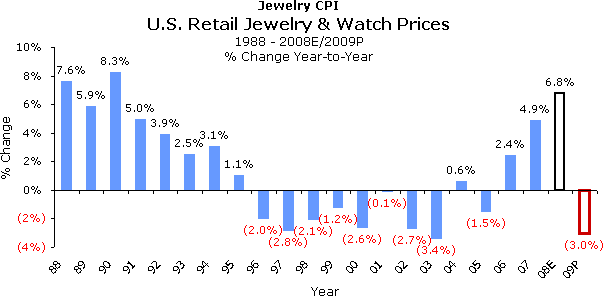
Source: BLS & IDEX Online
Jewelry Producer Price Index (JPPI) +1.1 percent in November
U.S. jewelry producer prices (JPPI) rose by a very modest 1.1 percent in November 2008, according to the U.S. Bureau of Labor Statistics (BLS). This was by far the smallest monthly gain this year, and primarily reflects retreating precious metals prices. In addition, retail jewelers have reduced the size of their re-orders; as a result, jewelry suppliers are offering all manner of price-based incentives to move merchandise.
There is still a backlog of high-cost goods in the distribution pipeline that suppliers need to pass on to their customers. But the good news is that the pressure is off – suppliers’ costs have moderated, so they aren’t being forced to continue to raise prices in the face of a weakening environment of consumer demand.
We believe that suppliers will likely hold off on any new price increases near term for one key reason: retail jewelers simply won’t accept higher prices in the current recessionary environment.
Because the wholesale community is so fragmented, no one supplier has pricing power. We’ve already seen some panic pricing by suppliers who are trying to move goods – at a loss, if necessary – to raise cash. In that kind of environment, any supplier who tries to raise prices will lose business.
For the year-to-date, jewelry supplier price inflation for jewelry in the U.S. market is running at an annual rate of +6.8 percent.
The following graph summarizes the monthly Jewelry Producer Price Index for inflation since the beginning of 2007. The percentage figures are based on year-to-year comparisons of the BLS Jewelry Producer Price Index.
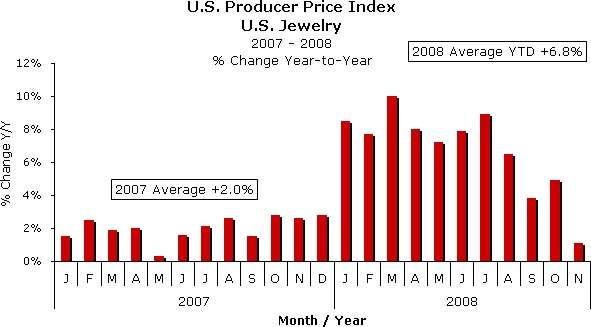
Source: BLS
What is behind this decelerating pace in the Jewelry Producer Price Index? Prices for both precious metal jewelry and gemstone jewelry have moderated. The graph below compares the JPPI (red bars) to inflation for precious metals (gold bars); gold has been the primary driver of precious metals inflation, until October.
We note, further, that producer price inflation in November was dramatically below the retail price inflation rate for the entire jewelry category. Earlier this year, producer prices in the precious metals category rose more than the corresponding retail prices. Now, retail prices are catching up, though it appears that inflationary pressures at the retail level have moderated significantly. However, these trends illustrate the lag effect – 3-5 months – between rising producer prices and the resultant rising retail prices.
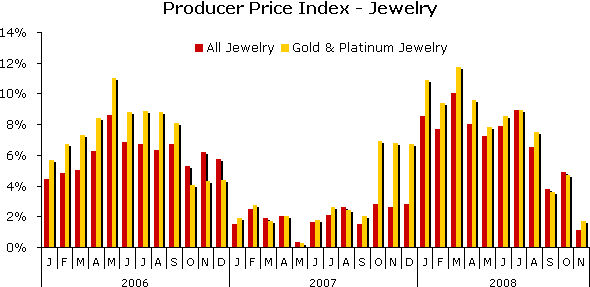
Source: BLS
Jewelry Consumer Price Index (JCPI) +6.4 percent in November
U.S. jewelry consumer prices (JCPI) rose by 6.4 percent in November, as calculated by the BLS. After rising sharply in March, April, and May, jewelry price increases at the retail level moderated in June, but re-accelerated in July and August. In September, there was a significant moderation in the jewelry retail inflation rate. In October, inflation picked up its pace, but fell back in November. For the year-to-date, retail price inflation for jewelry in the U.S. market is running at an annual rate of +6.9 percent, a level it has maintained for the past three months.
We believe that jewelry retail prices rose sharply early in the year as retailers re-priced goods to reflect pent-up inflationary pressures from their suppliers. Virtually all of the chain jewelers have raised prices, one way or another. For example, Kay re-priced its merchandise earlier this year. Zale has introduced significant new merchandise at higher retail price points while at the same time running clearance sales to move obsolete merchandise. Most independents have re-priced their inventory to reflect current precious metals and gemstone prices.
While there has been some inflation volatility on a month-to-month basis during 2008, the trend for the past four months is quite clear: jewelry price inflation at the retail level is moderating.
The graph below summarizes the percentage change in retail prices of jewelry and watches by month on a year-to-year basis since 2007. The percentage change is based on a comparison to the same month a year ago (November 2008 versus November 2007).
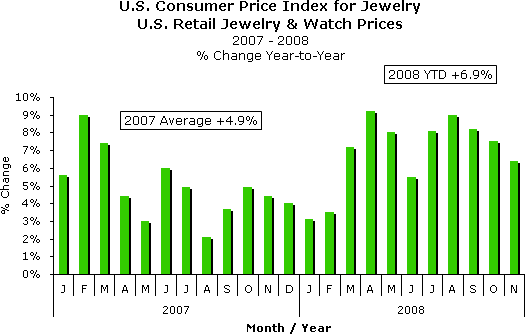
Source: BLS
Earlier this year, the components of jewelry and watch price inflation at the retail level reflected a disparity in price increases. Jewelry retail prices were up consistently during the first half of 2008, but watch retail prices showed virtually no price inflation. In the past few months, watch price inflation has steadily increased.
In particular, watch prices have risen sharply for the past two months, when compared to the prior months. We are not surprised; the only surprise is that watch price inflation lagged so much early in the year. Why? There are two key reasons: 1) mechanical watch mechanisms from Switzerland have been in short supply due to manufacturing capacity constraints; and 2) demand for high-end watches and branded watches has been relatively strong, according to retail jewelers. However, in recent weeks, we have heard that high-end watches are not selling at retail. In particular, jewelers tell us that Rolex watches are sitting in their showcases, and consumers aren’t asking for this prestigious brand in the current recessionary environment. Our forecast calls for significantly moderating price inflation for watches in 2009 – in fact, price deflation will occur, in our opinion.
The graph below illustrates the JPPI consisting of both jewelry and watch prices (green bars), jewelry prices only (red bars), and watch prices (yellow bars).
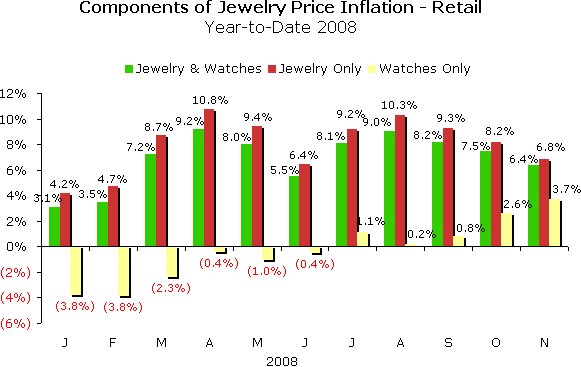
Source: BLS
Outlook: Price Deflation in 2009
Our forecast calls for both jewelry consumer prices and jewelry producer prices to rise by just under 7 percent in 2008, followed by price deflation in 2009. Our current forecast calls for 2009’s price deflation to be in the low single digit level, but because it is so early in the forecast cycle, we’d call this little more than an educated guess tempered by history (and that’s as good as it gets sometimes!).